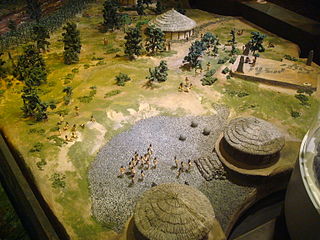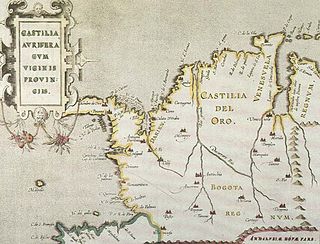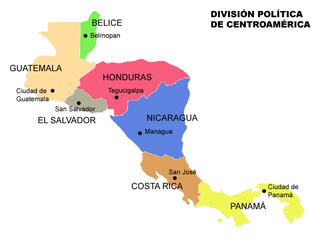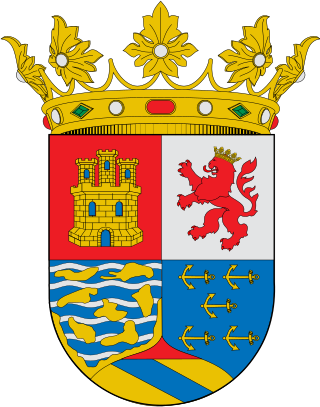
The first indigenous peoples of Costa Rica were hunters and gatherers, and when the Spanish conquerors arrived, Costa Rica was divided in two distinct cultural areas due to its geographical location in the Intermediate Area, between Mesoamerican and the Andean cultures, with influences of both cultures.

Bocas del Toro (Spanish pronunciation: [ˈbokas ðel ˈtoɾo]; meaning "Mouths of the Bull") is a province of Panama. Its area is 4,643.9 square kilometers, comprising the mainland and nine main islands. The province consists of the Bocas del Toro Archipelago, Bahía Almirante, Chiriquí Lagoon, and adjacent mainland. The capital is the city of Bocas del Toro on Isla Colón. Other major cities or towns include Almirante and Changuinola. The province has a population of 125,461 as of 2010.

During Spain's New World Empire, its mainland coastal possessions surrounding the Caribbean Sea and the Gulf of Mexico were referred to collectively as the Spanish Main. The southern portion of these coastal possessions were known as the Province of Tierra Firme, or the "Mainland Province". The Province of Tierra Firme, or simply Tierra Firme, was also called Costa Firme.

Castilla de Oro or del Oro was the name given by the Spanish settlers at the beginning of the 16th century to the Central American territories from the Gulf of Urabá, near today's Colombian-Panamanian border, to the Belén River. Beyond that river, the region was known as Veragua, and was disputed by the Spanish crown along with the Columbus family. The name "Castilla de Oro" was made official in May 1513 by King Ferdinand II of Aragon, then regent of the Crown of Castile.

Central America is a subregion of the Americas formed by six Latin American countries and one (officially) Anglo-American country, Belize. As an isthmus it connects South America with the remainder of mainland North America, and comprises the following countries : Belize, Guatemala, Honduras, El Salvador, Nicaragua, Costa Rica, and Panama.

The Duchy of Veragua is a hereditary title in the Peerage of Spain. It was also a Spanish hereditary domain created in 1537 in the reign of King Charles I in a small section of the territory of Veragua. The first Duke of Veragua was Admiral Luis Colón y Toledo, grandson and heir of Christopher Columbus. Holders of this title also hold the title of Admiral of the Ocean Sea. The establishment of the duchy was the resolution of a longstanding dispute between the Spanish Crown and the heirs of Columbus, who had claimed a greater area. Luis Colón was also made Marquess of Jamaica.
Royal Veragua was a Central American territory of the Crown of Castile established in 1537. It encompassed the western part of the former Gobernación de Veragua (1508–1537), from the Caribbean slopes from the Río Sixaola to the island Escudo de Veraguas, in what is now Panama. The eastern part was named the Duchy of Veragua and controlled by the heirs of Christopher Columbus. Royal Veragua lasted for only three years before being incorporated into the new Province of Nuevo Cartago y Costa Rica in November 1540, while the Duchy was sold back by Columbus' heirs in 1556 to the Crown and became Veraguas Province in 1560.

Nuevo Cartago y Costa Rica was a province of the Kingdom of Guatemala, created in 1540 during the reign of Charles V, Holy Roman Emperor. It was formed from two earlier Spanish territories. The first of these was Royal Veragua, the territories on the Caribbean coast that had been part of Columbian Veragua before the creation of the Duchy of Veragua in 1537 for Admiral Luis Colón y Toledo, namely present-day Nicaragua, Costa Rica and part of Panama. The second was the Pacific coast that had constituted Castilla de Oro, namely from the Gulf of Nicoya on the west to the borders of the Duchy of Veragua.
Nicoya is a canton in the Guanacaste province of Costa Rica. The head city is in Nicoya district.

The Spanish conquest of the Chibchan nations refers to the conquest by the Spanish monarchy of the Chibcha language-speaking nations, mainly the Muisca and Tairona that inhabited present-day Colombia, beginning the Spanish colonization of the Americas.
The western Caribbean zone is a region consisting of the Caribbean coasts of Central America and Colombia, from the Yucatán Peninsula in southern Mexico to the Caribbean region in northern Colombia, and the islands west of Jamaica are also included. The zone emerged in the late sixteenth century as the Spanish failed to completely conquer many sections of the coast, and northern European powers supported opposition to Spain, sometimes through alliances with local powers.
The Royal Audience and Chancery of Panama in Tierra Firme was a governing body and superior court in the New World empire of Spain. The Audiencia of Panama was the third American audiencia after the ones of Santo Domingo and Mexico. It existed three times under various guises since it first creation in 1538 until its ultimate abolition in 1751.
The Real Audiencia of Santiago de Guatemala, simply known as the Audiencia of Guatemala or the Audiencia of Los Confines, was a Real Audiencia in the Imperial Spanish territory in Central America known as the Captaincy General of Guatemala (1609-1821). The Audiencia's presiding officer, the president, was the head of the government of the area. The Audiencia was initially created by decrees of November 20, 1542 and September 13, 1543, and had its seat in Antigua Guatemala.
Nicarao was said to be the name of an indigenous chieftain or cacique who presided over a territory in southwestern Nicaragua during the early 16th century. Based on research done by historians in 2002, it was discovered that his real name was Macuilmiquiztli.

Indigenous people of Costa Rica, or Native Costa Ricans, are the people who lived in what is now Costa Rica prior to European and African contact and the descendants of those peoples. About 114,000 indigenous people live in the country, comprising 2.4% of the total population. Indigenous Costa Ricans strive to keep their cultural traditions and languages alive.

Costa Ricans are the citizens of Costa Rica, a multiethnic, Spanish-speaking nation in Central America. Costa Ricans are predominantly Castizos, other ethnic groups people of Indigenous, European, African and Asian descent.

The Governorate of New Andalusia was a Spanish colonial entity in what today constitutes the Caribbean coastal territories from Central America, Colombia and Venezuela, and the islands of what today are Jamaica, Cuba, Haiti, Dominican Republic and Puerto Rico. The Government of Nueva Andalucia was set in Venezuela from 1501 to 1513.

The Spanish conquest of Honduras was a 16th-century conflict during the Spanish colonization of the Americas in which the territory that now comprises the Republic of Honduras, one of the seven states of Central America, was incorporated into the Spanish Empire. In 1502, the territory was claimed for the king of Spain by Christopher Columbus on his fourth and final trip to the New World. The territory that now comprises Honduras was inhabited by a mix of indigenous peoples straddling a transitional cultural zone between Mesoamerica to the northwest, and the Intermediate Area to the southeast. Indigenous groups included Maya, Lenca, Pech, Miskitu, Mayangna (Sumu), Jicaque, Pipil and Chorotega. Two indigenous leaders are particularly notable for their resistance against the Spanish; the Maya leader Sicumba, and the Lenca ruler referred to as Lempira.
The Spanish conquest of Nicaragua was the campaign undertaken by the Spanish conquistadores against the natives of the territory now incorporated into the modern Central American republic of Nicaragua during the colonisation of the Americas. Before European contact in the early 16th century, Nicaragua was inhabited by a number of indigenous peoples. In the west, these included Mesoamerican groups such as the Chorotega, the Nicarao, and the Subtiaba. Other groups included the Matagalpa and the Tacacho.

The annexation of the Partido de Nicoya to Costa Rica is a historical event that refers to the incorporation of the territory of Nicoya to the State of Costa Rica, which occurred on July 25, 1824.












